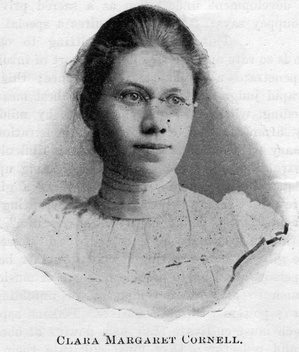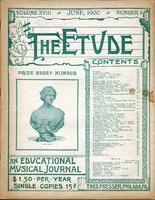Clara Margaret Cornell was born in Brooklyn, N. Y., but has passed the greater part of her life in New Jersey. She was graduated from the Asbury Park High School in 1890 and from Vassar College in 1896. At an early age she began to study vocal and instrumental music and painting under the best local teachers. She also studied several years at the Berlitz School of Languages. In Vassar she elected a broad course of study in science, history, and languages, taking also several courses in musical theory under Prof. G. C. Gow. Since graduation she has continued her study of the piano and has taken up teaching. Miss Cornell is interested also in literary and various forms of church work.
Much thought is being given to the question: “What method of music teaching is the best?” Any of the superior methods must fail in their efficiency if the teacher’s own methods of work are not based on good judgment. There are two indications of sound instruction,—the teaching of the pupil to concentrate the mind, and the observance by the teacher of a clearly-defined perspective in her work.
What is concentration? Have we ever paused to consider what a busy world ours is? How many things there are in motion about us, how many sights to see, how many sounds the moving things make, how many different qualities our sense of touch perceives? But are we conscious at one moment of the many sights, sounds, and tactual qualities of objects about us? We are distinctly conscious of but one thing. This thing, when the mind is not under restraint, is usually determined by the intensity of the sensations. Do we habitually allow our minds to be diverted by the most intense sensation of the moment, now a loud noise filling consciousness, next a pretty sight, then the smoothness of some object? If we do, we have no worthy thoughts. Ideas—thoughts—cannot be fostered without the fastening of the mind upon one subject to the exclusion of all others. This is concentration.
Every person knows how easy it is to attend to that which interests him. The aimless miller would surely find no greater difficulty in shunning the bright light than it would in keeping its mind from the interesting subjects. There are, therefore, two kinds of attention, the simple and the voluntary.
We are wont to consider voluntary attention a habit of the trained, adult mind. It should be a habit of every well-taught child. Education is not a cramming, but a drawing-out, process, and we cannot draw out much from an unthinking mind. We should teach our pupils to think, and not leave it to their own unaided efforts. If they study incorrectly, they waste time and miss the intended discipline. Psychology teaches several laws of mental phenomena that will aid us.
We know that if we are listening intently to something and we close our eyes we hear more distinctly. The closing of the eyes prevents the sight-center of the brain from receiving impressions to divert consciousness from the impressions of sound. Again, we keep out impressions of sound when we study by muffling the ears. Since, therefore, we want to help our pupils to pay strict attention, we should take care that arms and feet are kept quiet, head and eyes steady. Restless movements of the body not only diminish the store of energy, but invite impressions from the surrounding objects close to contact.
These laws again teach us that the ease of directing the attention at one moment is determined by the direction of the attention the preceding moment. It is easier, when one has been listening to sounds of any kind, to fix attention upon a tone, than when one has been admiring a beautiful painting. In order to make the lesson-period pleasant a habit of certain teachers intersperses their instruction with comments upon subjects of other interest. Doubtless, the pupil is amused, and never finds the hour dull. Does he never find the practice-period dull? As the pleasant time at the lesson had not been put into the music, how could the child draw it out in his practice? So the period is neither pleasant nor the practice profitable. Instead of chatting upon subjects of no aid to the lesson the teacher should be well prepared with apt illustrations and interesting anecdotes about musicians. This is merely another way of stating that a child does not know how to give voluntary attention to a subject, and that it devolves upon the teacher both to make the subject so interesting that attention need not always be forced, and also to devise means of making voluntary attention easier.
One method of stimulating interest is to get the pupils to ask questions concerning their work. The asking of intelligent questions on an uninteresting subject is not an easy task. An excellent recipe for finding questions is to have the pupils explain points in their lessons to older persons ignorant of music. The would-be teacher’s attempts to meet the questions of such persons with satisfactory answers will reveal to them their limitations, and suggest other questions. Their ability to explain satisfactorily such questions will awaken feelings of self-confidence and interest. We like to do what we can do well.
By psychological laws we are taught again that we give attention to music of strong rhythm more easily than to music of weak rhythm. The strong accents stimulate the mind to the expectation of their recurrence. The expectation intensifies the sensations of sound, and thus secures the attention easily. Music of strong rhythm, then, should be given to pupils who find their work uninteresting.
Still another method of exciting interest and of making strict attention easy is the painting of a word- picture upon the title of the piece, or the explanation of the title, allowing the imagination free play in suggesting thoughts full of life and color. A title painted vividly the pupil will never forget. It will be like a pair of rose-colored glasses to the piece.
So much for concentration. How shall the teacher observe a well-defined perspective in her instruction? By laying stress upon the most important ideas, impressing them firmly upon the pupil’s mind by original, fresh illustrations culled from childhood experiences. All other ideas should be grouped about the main one according to their relative importance. The teacher should not present too many ideas, lest the child’s impression be complex and confused. The pupil will increase in his power of retaining instruction as he learns to give close attention. The proper time in the lesson at which to explain the important points should be considered also.
The observance of perspective in one’s teaching should be given not alone to the lesson as a whole, but also to the entire course of instruction. A teacher may well ask herself: “What points in music-instruction are the most important?” “If in my teaching I lay the most stress upon this or that, what ideas concerning music-study will it give my pupils?” “Would their practice-period be profitable if they held that idea?” “How careful I should be in teaching beginners not to foster wrong notions concerning practice.”
Naturally, a child’s most decisive impressions of what music-study means are received in his first lessons. Music-study is necessarily a vague idea to him, for it is unlike any of his other studies. Whatever ideas the teacher presents in the first lessons which he can grasp easily he will clutch tenaciously. All ideas given later he will group about it, establishing some relation among them in his mind.
What is of the greatest importance in music—reading well at sight, ability to give the fingers gymnastic exercises upon the keys, or the quality of tones? We all answer: It is the production of lovely, exquisitely-shaded tones. The production of such tones implies fine technic, and some skill in sight-reading, but neither good technic nor great ability to read at sight implies sweet tones. Clearly, then, we must show the pupil from the first lessons that music-study is a study of tones.
The best way to accomplish this is to give ear-training before taking up finger-work or note-study. The child’s work and play have developed ability to use the fingers easily, to see quickly, and to perceive similarity of form. His ear has not received special training. It seems better, then, that his perception of sounds should be developed at least as much as his perceptions of sight and of touch. When the child has gained some proficiency in recognizing sounds and their qualities, it would seem best to teach him how to produce those sounds correctly. He should understand well each movement involved before attempting to make it. Its proper production should be practiced until done automatically. The teacher should not fail to connect in the child’s mind the quality of tone produced with the manner of producing it so that when the work has become easy, at the mere mention of the quality the child will produce it automatically.
Doubtless the best methods of teaching music possess in common other characteristics than those treated of in this essay. These two, the teaching of concentration of the mind and the mapping out of one’s work ahead of time clearly and consistently to an ideal, are of the greatest importance in the teaching of all branches. They are fundamental principles. They are, therefore, of greater value to music than characteristics which pertain to music alone.




